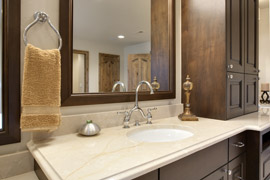 Marble has both a scientific and commercial definition. Scientific marble was once limestone that achieved metamorphosis from intense pressures and high temperatures within the earth. This altered its crystalline structure and introduced other minerals that produced the valuable colors and veining. Commercially, any stone capable of taking a polish (with the exception of granite) is known as marble. This includes travertine, onyx, serpentine and limestone. Marble is found in the mountainous regions of Canada, Italy, Germany, Spain, the U.S., Greece and other countries worldwide.
Marble has both a scientific and commercial definition. Scientific marble was once limestone that achieved metamorphosis from intense pressures and high temperatures within the earth. This altered its crystalline structure and introduced other minerals that produced the valuable colors and veining. Commercially, any stone capable of taking a polish (with the exception of granite) is known as marble. This includes travertine, onyx, serpentine and limestone. Marble is found in the mountainous regions of Canada, Italy, Germany, Spain, the U.S., Greece and other countries worldwide.
Best Application for Marble –
Ideal for foyers, bathrooms, floors, and hearths.
Most Common Uses –
Marble adds a sophisticated element to your home, and its wonderful appearance, superior engineering characteristics, and ease of maintenance makes it a natural choice for floors, wall coverings, fireplace facing and hearth, table tops, and bathroom walls, floors, vanity tops, tub decks, and showers. Marble should be cared for as you would a fine wood finish. Using coasters on tabletops and cleaning up spills immediately will preserve marble’s natural beauty as it is senstive to citric acid and spills.
Serpentine is another option for marble-loving homeowners that uses another natural stone for kitchen counters. Sometimes called the “green” marble, serpentine is not a true marble but offers a marble-like look. Because it is magnesium-silicate based, it is not sensitive to citric acid and other kitchen spills like traditional marble.
